-
Posts
1,155 -
Joined
-
Last visited
-
Days Won
1
Content Type
Profiles
Forums
Blogs
Gallery
Events
Store
Posts posted by RobW
-
-
Just some information what I saw...
Poset up by Tom Nier on the US Militaria Forum;
Hello Timo,
Thanks for the pic of the catalogue. It is good reference.
I have a picture of the CANTIGNEY clasp somewhere. If I can track it down I shall post it for reference.
Regards,
Rob
0 -
-
Hey Rob,
Could you post a photo of the stamping on this medal.
Jim
Jim,
Poor photography skills aside, I shall attempt to photograph the rim of the medal when I have the opportunity.
Regards,
Rob
0 -
Hello Jim,
Thanks for the detailed reply.
I would clarify different areas separately.
You have mention again, as you have in the past, that you believe that the "DEFENSIVE SECTOR" type clasp, that is attached tothis medal, was a product of Bailey, Banks & Biddle Co. Having 23 loose clasps of this type myself,has enabled me to examine the back straps of each one. To date, I have not found one with the BB&B stamp on them. In talking to BB&B collectors and asking them if this type clasp was too small to warrant a stamp, the answer has always been "no". They have shown me items much smaller with the BB&B stamp. Again having said that, I believe as well, there still might be a BB&B connection to this clasp or maybe another type clasp I own. Since you feel so strongly that this type clasp is a BB&B, have you found the missing link like a catalog or a good photo document that can be shared and would shed some light on this subject?
* BBB clasp. Discussions I have had with other US collectors have indicated that some BBB items were also not marked on the reverse.
In Alexander Laslo's Vic book, 2nd Edition, he specifically mentions a BB&B clasp of the same design as the DEFENSIVE SECTOR clasp shown. There is illustrated an 'Army Of Occupation' clasp on page 119, that is the same and in the text below it indicates that said Army Of Occupation clasp was manufactured by BB&B, and appeared in George Studleys catalogue of 1939. Timo's post above helpfully shows a later catalogue of the same list.
I would assume that Alexander Laslo had some good and conclusive information to suggest such a link between the clasp design and the firm of BB&B. If other US collectors have information to suggest otherwise it would be helpful to share it here as well.
I have attached a picture of a clasp, 'Army Of Occupation' that is the same as that illustrated in Alexander Laslo's book.
You mention that you have spoken to other BB&B collectors. It would be good to receive their input as, apart from yourself and Tim B, there are not that many other regular US posters on this particular thread. The more the merrier and it may help us all out.
The brooch on this medal is very close to the French-made repro victory medals, so could there be a connection? See my attached posting#1.
* Split brooch. It has been indicated to me that the Split Brooch is of US production that was used on period manufacture pre-world war 2 US medals. The earlier version being the split wrap brooch with stocks of the other variety, being the Full Wrap brooch, running out sometime in the early 1940s. Is this correct??
Regards,
Rob
0 -
Is it possible that the MC after Major Patten's name is a post-nominal for the British MC. During World War I the British Army had a shortage of medical officers and quite a few US Army medical officers were attached to the British Army and a number of them were awarded the Military Cross. Gunner 1
Hello Gunner 1,
I had also considered when viewing the naming for the first time that M.D. may have implied medical doctor but wasn't too sure. If this was to be the case it would certainly make it even more interesting.
Regards,
Rob
0 -
To all,
I picked up this nice US vic about 6 months ago but hadn't paid a lot of attention to it due to other competing activities. While the item is a nice clean piece it has a number of interesting points:
* The AISNE-MARNE clasp has no spacers. This is one of the varieties that were produced with no spacers.
* The DEFENSIVE SECTOR clasp is of an unofficial variety produced by the Bailey, Banks and Biddle firm.
* The unusual split suspender is of interest.
* The top four battle clasps all have a different finish and patina.
Looking at the edge I noted some markings and upon closer inspection I noted the medal had been named stamped along the left edge (as viewed). The engraving appears to be hand stamped block letters that are of the width of the medal (circa 2.5mm wide).
The medal is so named: WM. F. PATTEN M.D. MAJOR M.C.
I am aware that named US vics are more predominantly seen on US navy specimens and I haven't seen many US army vics named. While the markings in this case are sufficiently vague do any of our US members of the forum and this thread in particular have any thoughts or clues as to the identity of origin of such an individual?
Happy for all thoughts.
Regards,
Rob
0 -
To All
Can someone post a large and clear side by side illustrationof both the obverse and reverse sides to show the different between the Italian"Official type 1" and the Italian "Reissue type 1" sincethey both are by the same manufacturer but at different time period.
Thanks JM
Hello JM,
I have both pieces in my collection. When I have time I will track the pieces down and do a side-by-side scan.
Regards,
Rob
0 -
Tim
After enlarging Lasko's photo and seeing that the top point of his five pointed star completely covers the buckle's top cross bar which is around 3mm. Laslo's star which he illustrated is much larger then 3mm. The open area inside the buckle is 6mm+. Was there a misprint of a 3 when it should have been an 8, I do not know?
But in my illustration you see that there are 10 threads in the middle section of the buckle, it take's 4 threads to equal 3mm. I placed a star which is 3mm on the top cross bar of the buckle. See how much smaller it is than the star in Laslo's illustration?
Having said that, I agree, what we need is more information, more documentation and a good Portuguese medal collector.
(JM)
Hello JM,
It is mentioned in the second edition of Mr Laslos book that 'this five-pointed star has a radius of 3mm'...
Radius is defined as:
1. a straight line extending from the centre of a circle or sphere to the circumference or surface;
2. a right line drawn or extending from the center of a circle to the periphery;
3. a straight line from the centre to the perimeter of a circle (or from the center to the surface of a sphere);
or in this case the centre to the outer edge of the star.
Sources:
1. The Macquarie Dictionary, 2nd Ed 1991
2. New Oxford American Dictionary, 2nd Ed 2005
2. The Collaborative International Dictionary of English v.0.48
3. WordNet ® 2.0
4. www.dict.org
That would be measured from the centre of the star to the outside edge of the points. A total of 6mm would be derived from an edge to edge measurement at its widest points. This of course doesn't take into account minor manufacturing differences. I believe that would be more consistent than a 3mm star.
Regards,
Rob
0 -
Oh, and what I found from one of my boxes, even didn't remember that I have one from Italy....
Hello Timo,
That is a nice official type 4 vic. It doesn't have any makers mark on the front right hand side.
This type is seen much less than those manufactured by Sacchini, Johnson and F.M Lorioli-Castelli. A nice pickup.
Regards,
Rob
0 -
My illustration shows a yellow box around one with three stars in it. The two stars on each end are silver and note how dull they are. All "metals" oxidize to some degree no matter how well they are kept. Yet, the photo of the star on the top of my earlier posting looks like it just came out of the box. The medal and star in question is on the bottom of my latest posting.
(JM)
JM,
On the medal in question; when actually reviewing the piece in my hand the small star is not so shiny as it appears in your picture and has lost some of the silver finish.
Again it would be good if this discussion could be moved to the main vic thread as it contributes to that subject. Any thoughts??
Rob
0 -
Hello JM,
As has already been alluded to the more regularly identified star, found on the Portugal vic is much smaller and in a silver finish.
Of note is that while the particular ribbon is definitely attributable to that of Portuguese manufacture (there are many varieties of the vic ribbon directly attributable to specific countries which aids in authenticity) the ribbon buckle shown is less likely to have been original to this vic.
Ribbon buckles are commonly seen on a wide variety of Portuguese medals and in this case the ribbon buckle is significantly narrower than the accompanying ribbon. The ribbon buckles that are regularly seen on portugal vics are both narrower in width and depth but also have a more bronzed finish. They are also generally flush with the edge of the ribbon.
It is likely that such a buckle has been placed on this vic, with the larger than normal ribbon stars to embellish the award.
This information would also add to the long running general vic thread.
Regards,
Rob
0 -
Since I have never handled one I have no first hand information on it.
1. What would be the reasoning for silver? elitism?
2. Was this one sprayed as it seems the silver is chipping off, and there is not hint of silver in the exposed parts of the bronze. Most illustrations I have seen were plated or as one person listed, it was solid silver?
3. Do you feel it was done in an aftermarket or by the manufacturer?
Regards, Johnmac (JM
Hello JM,
To answer your questions:
1. As far as I've been able to determine this was done by the manucturer. It is not unlikely that it was done to enhance a recipients group but I wouldn't use the word 'elitism'.
2. It is merely silver plated over bronze. I have seen a small number of italian and french unofficial vics that have been similarly silver-plated.
3. The manufacturer, in this case Stefano Johnson of Milan, produced a limited quantity of silvered-bronze items, as well as some in silver. I have also seen a shiny bronze, gilt finish variety.
Regards,
Rob
0 -
-
Hi Rob,
Nice trio!
Do you suspect the box came issued with the three medals like this, or that someone placed them with the dividers into one cardboard container? Never seen this before like this... Interesting.
Tim
Hello Tim,
Yes I believe that the box is a period piece for this set of three.
The tops of the dividers are glued in to the box so can't move too much. There are consistent wear marks on the box which is of the correct pattern and style for that produced by the many French medal manufacturers of the time. There are marks showing the distinct outlines of all three medals on the bottom of the box which corresponds with all three medals.
When I inquired with the vendor he indicated that there were a few manufacturers that put out this form of boxed set, generally in the period of the early 1930s.
I am satisfied that it is a period piece and not a put together set.
Regards,
Rob
0 -
-
To all,
Here is a French vic related item of note. I recently obtained this nice set of 3 medals complete with its own box. It is a plain blue cardboard box with dividers. Simple yet effective. While I have seen many individually boxed vics, and other period French medals in their plain red or blue boxes, I had not seen such a combined box set up before.
The medals have their original attachments pins and the following makers marks:
* Commemorative War Medal - Paul Leclére
* Vic - Paris Mint
* Combatant Cross - Janvier Berchot
Of note is that the vic has the same very fragile ribbon that is generally seen on the official Greek vic that was produced and distributed in the green box of Victor Canale, Paris. This boxed set of 3 would be dated sometime in the early 1930s due to the presence of the Croix du Combattant (instituted 28 June 1930).
Close-ups of the medals to follow.
Regards,
Rob
0 -
I've seen a wide variation is suspension ribbons on these, ranging from the tri-fold, straight, and Romanian style. Was the tri-fold ribbon the one typically worn on the Serb uniform??
Tim
Examples:
Hello Tim,
I have seen these medals mounted on a long group with the ribbon as the backing similar to a court-mount. On the other hand I have also seen photographs of Serb soldiers wearing the individual medals on the tri-fold ribbon attached to their tunics. The straight ribbons are generally seen on French groups, as many French and other allied forces had troops on the Salonika front for quite a while. One of my award certificates was accompanied by the commemorative medal with straight ribbon as per your picture.
The Romanian style looks like a bit of 'creative licence' was taken as it is not even the correct ribbon.
Regards,
Rob
0 -
-
To all,
While not a Planchet publication I am also looking for a copy of the US Navy Department General Order of 1920 establishing ship entitlement to the Navy bars of the US vic. I have a copy of the subsequently amended 1953 list but am specifically looking for the 1920 version.
I would be happy to find the original pubs or even copies. If anyone can help it would be appreciated.
Regards,
Rob
To all,
I have managed to find an extract from Navy General Order 528 of 25 April 1920 that has the list of ships eligible for Navy clasps. It is contained as an appendix in the fine publication on US medals 'The Call Of Duty' by Strandberg and Bender.
I am, however still looking for a copy of: World War I Campaign and Service Credits, Albert F. Gleim, Planchet Press Pub No. 21
Regards,
Rob
0 -
I might also have an opportunity to acquire some nice examples of the War Cross and wanted some opinions from the other members here. The shots are not the best, but all I have for now.
As I am not that familiar with some of these, I would like to bounce the different attachments off members to see if they can identify some of the less common pins.
Tim
Here's a group PIC:
Hello Tim,
Yes they are very nice war cross' indeed. Although I cannot say for certain I would suggest that apart from the various linden leaf and star attachments, the skulls and others are unofficial attachments placed on by the recipients.
A collector acquaintance of mine in Prague has suggested that since most of the Czech-Legion soldiers did not remain in the Army post the Great War they would not necessarily followed the dress regulations hence the large variety of unofficial attachments.
Regards,
Rob
0 -
Hello Tim,
I have had a chance to peruse some of my French medal catalogues and references from the 1920s and 1930s.
Listed in M.Delande's July 1923 catalogue, page 7 is the following entry: 'Modèle Officiel Belgique avec ruban ordonnance 36mm, 5 francs' so they did at least produce the Belgian vic as well as a number of other Belgian great war medals.
In addition to this reference, in the marvellous 1934 Delande volume 'Décorations France Et Colonies, Croix Et Médailles De La Guerre 1914-1918 Des Pays Alliés, there is such an illustration matching the example you have posted, sans makers marks (page 95).
The pictures in this 1934 volume are quite superb. There has been a German 2001 re-published version of this reference but it is produced on poor quality grainy paper which degrades the illustration quality. If you can find an original copy I would recommend it to all.
I have a few other M.Delande produced pieces that are also illustrated in the 1934 volume and the pieces are exactly the same as the illustrations.
Hope this is of assistance.
Regards,
Rob
0 -
I feel as though I need to quote the whole of Laslo's text - it really is very informative... ?
Does anyone have any of the unofficial Italian Vic medals?
best regards
Thomas
Hello Thomas,
Yes I have the unofficial type 1 Italian vic. They are particularly hard to find even among Italian collectors. It has been posted earlier in this thread (posts # 74 & 75). I obtained it direct from an Italian collector. There are quite a number of modern reproductions of this unofficial type 1 so it pays to be wary and ensure the originality of the piece.
Hope this helps.
Regards,
Rob
0 -
A little closer

Hello Tim,
The example you have posted was produced by the Swiss firm of Huguenin Frères.
It has the silvered eyelet on the reverse of the ribbon. On the obverse near the bottom right (leaf near the cannon wheel) is the 'Huguenin' makers mark and the names of the battles on the leaves on the reverse is particularly distinct.
It was also produced by the French firm of Arthus Bertrand and a number of unidentified manufacturers in Serbia.
Regards,
Rob
0 -
Besides the atypical brooch attachment, you'll notice the details are very defined and the designer's name and E.D.B. are missing.
Anyone else have one of these?
Tim
Hello Tiim,
While I don't have one of these varieties in my collection I recall seeing an illustration of just such a French produced Belgian war commemorative without the makers marks. It was listed in an M. Delande, of Paris catalogue of 1923 as well as another of 1930. When I have time I will re-check these references and provide an update.
Regards,
Rob
0






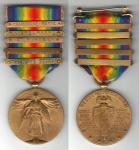
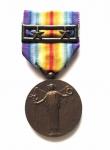

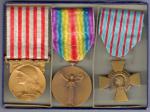
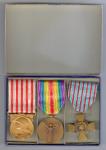
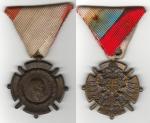
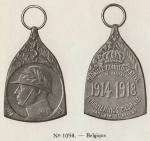
American (US) Victory Medals
in Inter-Allied Victory Medals of the Great War
Posted
Hello Jim,
Are there any markings on the reverse of the Serbia clasp or is it plain?
Regards,
Rob